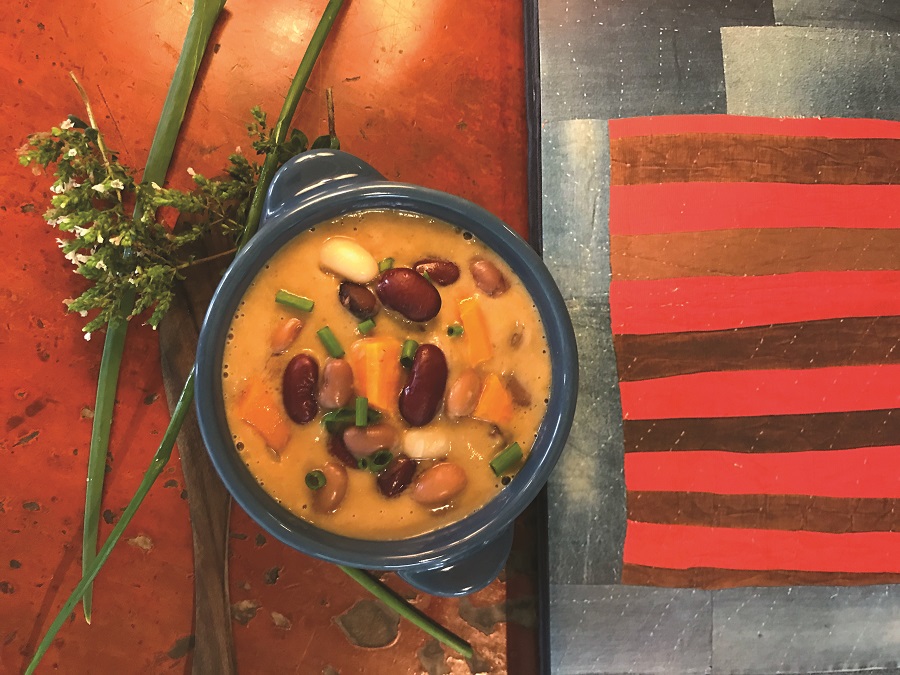Before the first nip of chilly air arrives, I dust off the soup pot — an autumn ritual set off by early sunsets and the first orange-tinged leaves, or maybe by the hummingbirds’ abrupt departure.
Hunting for the pot, which is probably in the mudroom under a stack of beach towels, I consider choices: the magnificent hue of butternut and ginger soup? Apple and cauliflower, creamy turnip, or bean? I usually open the season with bean soup for all the nutrition, flavor, comfort, and convenience dried or canned beans offer. Stocked on my shelf, they wait for the cook, with no shopping needed.
The promise of bean soup raises Hugo’s hopes that it will be a simple Tuscan version, and it often is. His favorite Tuscan soup has cannellini beans, rosemary, and of course olive oil.
But there’s another bean soup I favor — one that evokes the memory of legendary quilts I saw a couple of decades ago and have never forgotten. The quilters from Gee’s Bend, a small, isolated enclave in Alabama, have turned out some of the most extraordinary quilts anywhere.

When I set out to simmer beans, I think of Annie Pettway, one of these artisans. According to The Quilts of Gee’s Bend (Tinwood Books, 2002), when Pettway went into the fields each morning to pick cotton, till, and harvest corn and peanuts, she took along her cooking pot.
Building a fire in the field, she set peas to cook — undoubtedly field peas, which are a type of bean. Returning to the end of each long row, she tended the fire, and by the end of the day supper was ready. She then walked several miles home, carrying her pot of beans.
I cherish this image of the quilters’ resourcefulness. Many of them, with an ancestry of enslavement, toiled as sharecroppers, yet they retained the resilience to create warm bedcovers of unforgettable beauty from scraps of fabric, old socks, denim, and feed sacks.
The Gee’s Bend quilts, brilliantly created from necessity, have an improvisational quality. Which is also a quality of any good pot of beans. You can make what you wish from lowly beans by adding ham or bacon, a bunch of late-season herbs, or handfuls of chard, kale, or spinach; all these complement a basic pot of beans — or soup, if you’ve added more liquid.
Choose one type of bean: pintos, great northerns, cranberry beans, chickpeas. Or combine several in one pot. Cook slowly, as the quilters did and still do with dried beans, or quickly with canned ones. Just go wherever your supplies and heart take you.
In Gee’s Bend, they celebrate the airing of the quilts, an old-time homemaker’s task, in early October. North and south, it’s time to put on the soup pot and air the quilts.
PANTRY BEAN SOUP
Makes 7 servings
3 Tbsp. cooking oil
1 onion, chopped
1 carrot, chopped
2 garlic cloves, chopped
Salt and pepper
4 cups water
3 15-ounce cans beans, drained (or equivalent quantities of cooked dried beans, simmered according to package instructions or any basic recipe)
1 bay leaf
1 tsp. thyme
1 tsp. dried oregano or basil or a handful of fresh herbs
1/3 cup cooked ham or bacon (optional)
2 cups chopped fresh kale, chard, or spinach
- In a soup pot, heat the oil over low heat, adding the onion, carrot, and garlic along with a good pinch of salt and several grinds of black pepper. Stir, cover, and cook for a few minutes.
- Raise the heat to medium high and add the water, beans, and herbs (also ham or bacon if you are using it). Cover and maintain an easy simmer for about 30 minutes.
- Remove pot from the heat and mash some of the beans, or place about a third of the soup in a blender or food processor and carefully puree until it’s smooth. (To prevent an explosion of hot soup from the blender, leave the vent on the cover open and hold a dish towel tightly over the lid while blending. Or allow the soup to cool before you whirl.) The mashing gives a more rustic result, the blender, a creamier one.
- Return soup to the pot and stir. Taste for seasoning and add more salt and pepper as needed. If you are including kale or chard, add it now and cook for a few minutes until it softens. Spinach only needs a minute of cooking.
- Ladle the soup into bowls and top each bowl with chopped fresh herbs.



